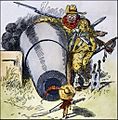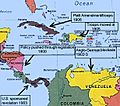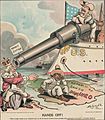American imperialism facts for kids

American imperialism describes policies aimed at extending the political, economic, and cultural control of the United States over areas beyond its boundaries. It may include military conquest, gunboat diplomacy, unequal treaties, subsidization of preferred factions, economic penetration through private companies followed by intervention when those interests are threatened, or regime change.
The policy of imperialism is attributed to the late 19th century. The government of the US has never referred to itself as an empire, but some refer to it as such.
At one time this influence included expansion into foreign territories. Expansionism was a primary objective of most empires, an example being the British Empire. Modern imperialism started in the 15th century when European countries discovered, and fought to claim, the New World.
American imperialism began in the 1890s. In 1896 the US annexed the Hawaiian Islands. After the Spanish-American War the US annexed Puerto Rico, Guam, and the Philippines. In 1914 the US completed the Panama Canal.
The Roosevelt Corollary to the Monroe Doctrine increased US influence in Latin America. It was the basis for Roosevelt's Big Stick policy. The US evolved from expansionism towards being an influence on world affairs.
The United States has also been accused of neocolonialism, sometimes defined as a modern form of dominance that uses economic rather than military power.
Pros and cons
Some of the advantages of American imperialism include:
- advancing American economic interests, such as trade
- preventing European intervention in the Western Hemisphere
- expanding America's influence in different parts of the world
However, American imperialism also has it negative sides, such as:
- violence, mistreatment and abuse of local population
- high costs
- exploitation of resourses
- use of economic and political pressures to impose American values and safeguard American interests
Images for kids
-
1898 political cartoon: "Ten Thousand Miles From Tip to Tip" meaning the extension of U.S. domination (symbolized by a bald eagle) from Puerto Rico to the Philippines. The cartoon contrasts this with a map of the smaller United States 100 years earlier in 1798.
-
U.S. westward expansion–portions of each territory were granted statehood since the 18th century.
-
Caricature by Louis Dalrymple showing Uncle Sam lecturing four children labeled Philippines, Hawaii, Puerto Rico and Cuba, in front of children holding books labeled with various U.S. states. A black boy is washing windows, a Native American sits separate from the class, and a Chinese boy is outside the door. The caption reads: "School Begins. Uncle Sam (to his new class in Civilization): Now, children, you've got to learn these lessons whether you want to or not! But just take a look at the class ahead of you, and remember that, in a little while, you will feel as glad to be here as they are!"
-
One of the New York Journal's most infamous cartoons, depicting Philippine–American War General Jacob H. Smith's order "Kill Everyone over Ten," from the front page on May 5, 1902.
-
American troops marching in Vladivostok during the Allied intervention in the Russian Civil War, August 1918
-
Protest against the deployment of Pershing II missiles in Europe, The Hague, Netherlands, 1983
-
On the cover of Puck published on April 6, 1901, in the wake of gainful victory in the Spanish–American War, Columbia—the National personification of the U.S.—preens herself with an Easter bonnet in the form of a warship bearing the words "World Power" and the word "Expansion" on the smoke coming out of its stack.
-
1903 cartoon, "Go Away, Little Man, and Don't Bother Me", depicts President Roosevelt intimidating Colombia to acquire the Panama Canal Zone
-
In 1899, Uncle Sam balances his new possessions which are depicted as savage children. The figures are Puerto Rico, Hawaii, Cuba, Philippines and "Ladrone Island" (Guam, largest of the Mariana Islands, which were formerly known as the Ladrones Islands).
-
A U.S. soldier stands guard duty near a burning oil well in the Rumaila oil field, Iraq, April 2003
-
Naval Base Guam in the U.S. territory of Guam
-
Map of the United States and directly controlled territories at its greatest extent from 1898 to 1902, after the Spanish–American War
-
A map of Central America, showing the places affected by Theodore Roosevelt's Big Stick policy
-
McDonald's in Saint Petersburg, Russia
-
Political cartoon depicting Theodore Roosevelt using the Monroe Doctrine to keep European powers out of the Dominican Republic.
See also
 In Spanish: Imperialismo estadounidense para niños
In Spanish: Imperialismo estadounidense para niños




















